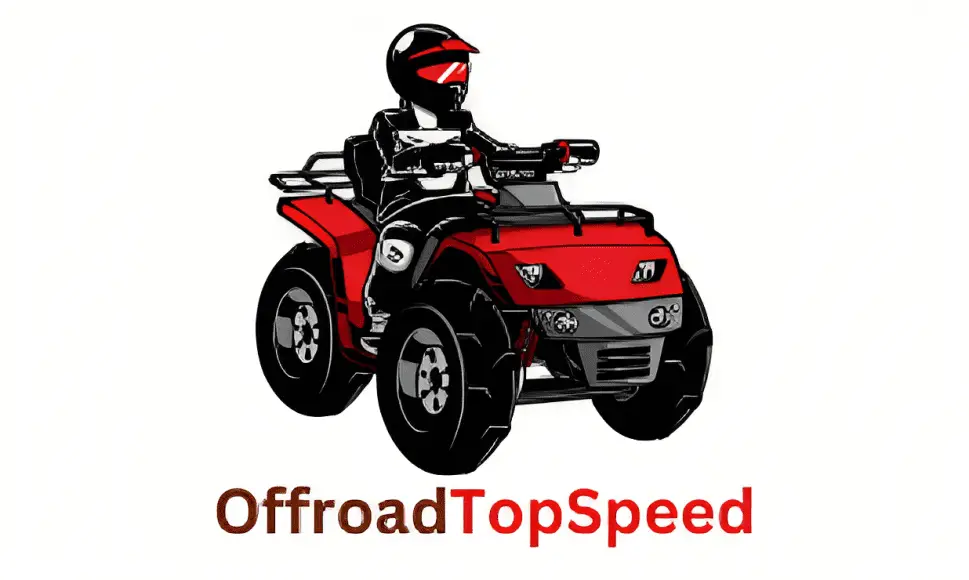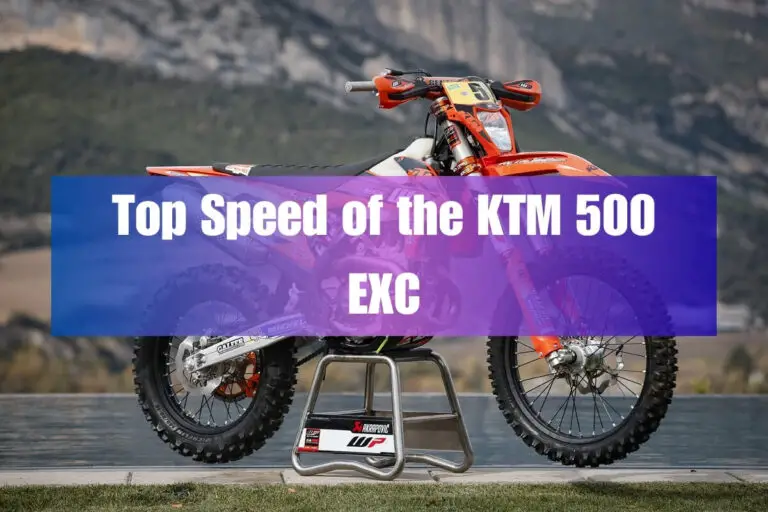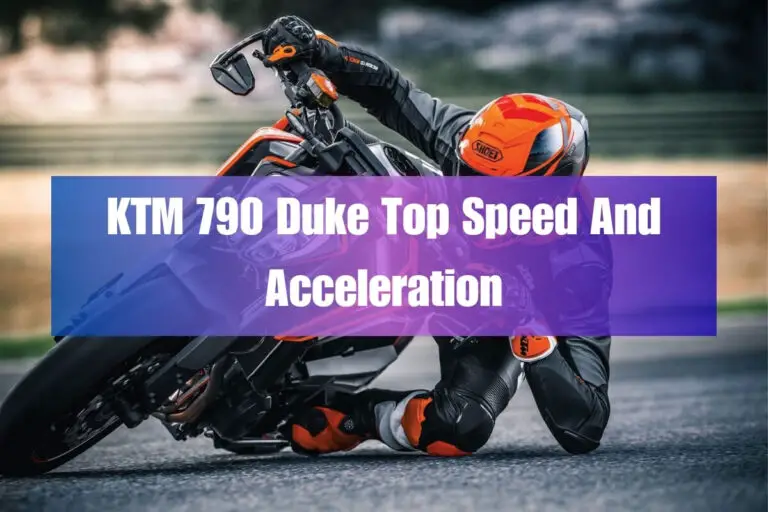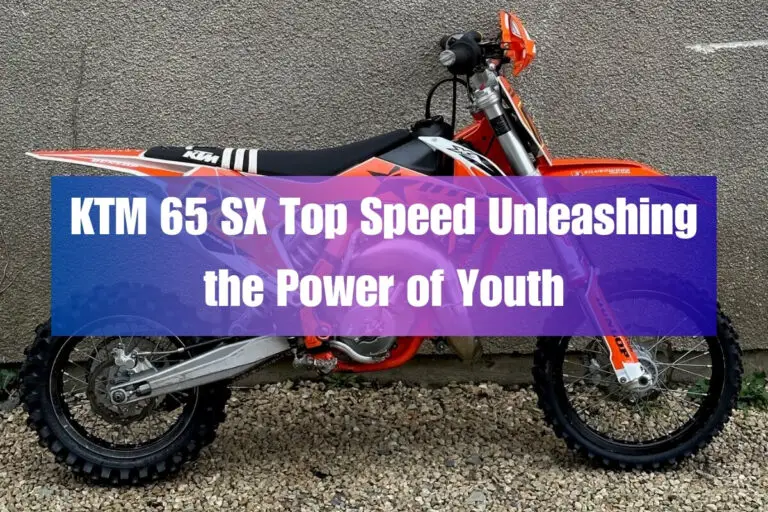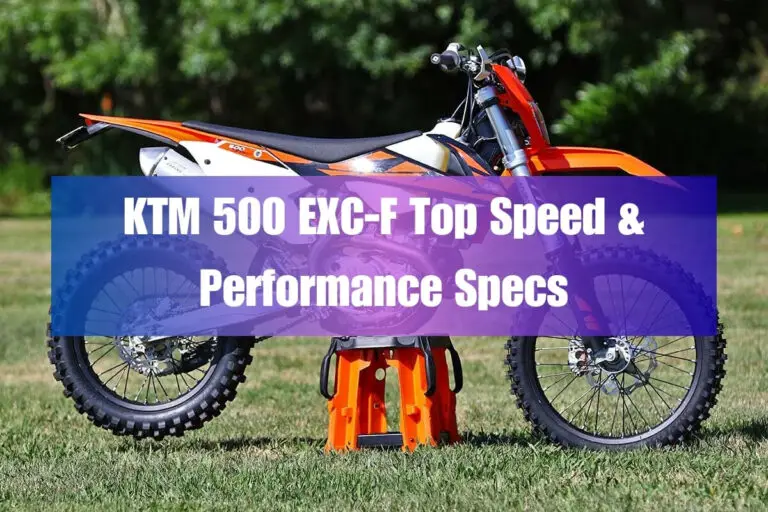ktm duke 390 top speed: Tested by experts!!
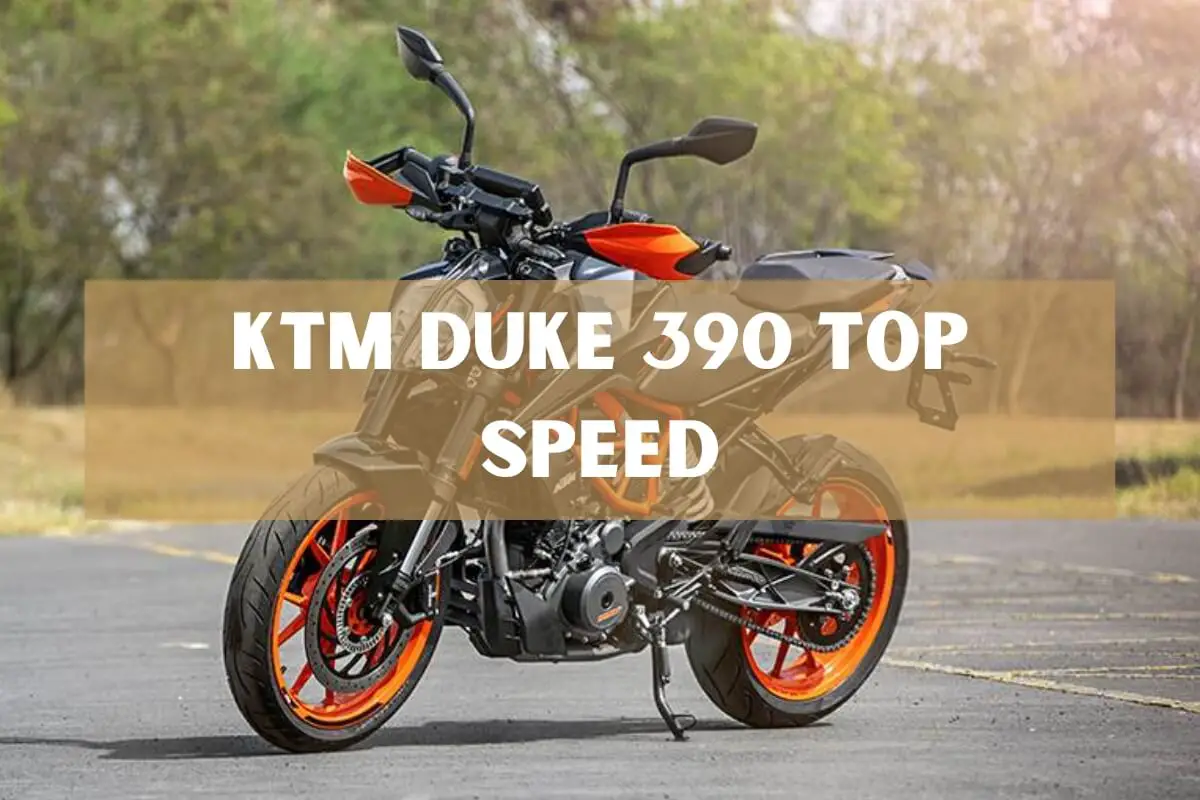
The KTM 390 Duke has earned a reputation as a swift, nimble machine. With KTM’s racing pedigree, buyers expect Duke models to deliver brisk acceleration and high top speeds relative to their engine sizes.
But how fast can the 373cc Duke really go? Does this lightweight single have the power to compete with bigger bikes on speed?
The 2023 KTM 390 Duke can reach a GPS-verified top speed of 106 mph (171 km/h) under ideal conditions. Real-world top speeds will vary by rider and conditions, but ~100 mph is achievable. While not as fast as 600cc+ sportbikes, the newest 390 Duke exceeds government highway limits and outruns some larger bikes. Read on to learn what gives this bike legitimate speed capabilities.
We’ll break down the engine performance, chassis dynamics, and design factors allowing the sub-400cc Duke to blur the line between beginner bike and miniature sportbike. Key topics include:
- KTM 390 Duke engine specs and power delivery
- Chassis and handling attributes for stability at speed
- Aerodynamics and drag-limiting features
- How conditions and modifications impact max velocity
- Real owner impressions on acceleration and speed
- Top speed vs competitor lightweight/middleweight bikes
- Step-by-step description of hitting top speed
Plus pros, cons, and alternatives from a speed perspective. Let’s explore why this little Duke can trade paint with bikes twice its size.
KTM 390 Duke Specifications
| Spec | Duke 390 |
|---|---|
| Manufacturer | KTM |
| Model | Duke 390 |
| Engine Type | 373cc, Single-Cylinder |
| Fuel System | Fuel Injection |
| Power | 44 hp @ 9,000 rpm |
| Torque | 27.2 lb-ft @ 7,000 rpm |
| Transmission | 6-Speed |
| Clutch | PASC slipper and self-servo wet multiplate clutch |
| Frame | Steel Trellis, powder-coated |
| Suspension (Front/Travel) | WP APEX 43 mm USD fork / 5.6 in |
| Suspension (Rear/Travel) | WP APEX mono-shock / 5.9 in |
| Brakes (Front) | 320 mm Disc |
| Brakes (Rear) | 230 mm Disc |
| ABS | Bosch 9.1 MP Two-Channel ABS |
| Tires (Front) | 110/70-ZR17 |
| Tires (Rear) | 150/60-ZR17 |
| Rake/Trail | 25° / 3.5 in |
| Wheelbase | 53.4 in |
| Seat Height | 32.3 in |
| Ground Clearance | 7.3 in |
| Fuel Capacity | 3.5 gal / 0.4 gal reserve |
| Dry Weight | 328.5 lbs |
| Warranty | 24 Month Limited Warranty |
| Colors | Orange, Black |
| MSRP | $5,899 |
Small Engine, Big Power
The Duke’s 373cc thumper punches above its weight class. Tuned for a competitive power-to-weight ratio, the liquid-cooled single generates 44 hp measured to stringent Euro 5 standards.
That may seem tame against 200+ hp superbikes, but it equates to ~35 hp per liter – on par with 600cc sportbikes. Combined with just 328.5 lbs to push around, the mini Duke has a power-to-weight ratio exceeding most traffic and many big bikes.
This grunty engine offers responsive low-end torque then screamer revs near the 10,500 rpm redline. The result is a wide powerband allowing the 390 Duke to exit corners quickly and sustain high speeds on straightaways.
Trellis Frame And Suspension Setup
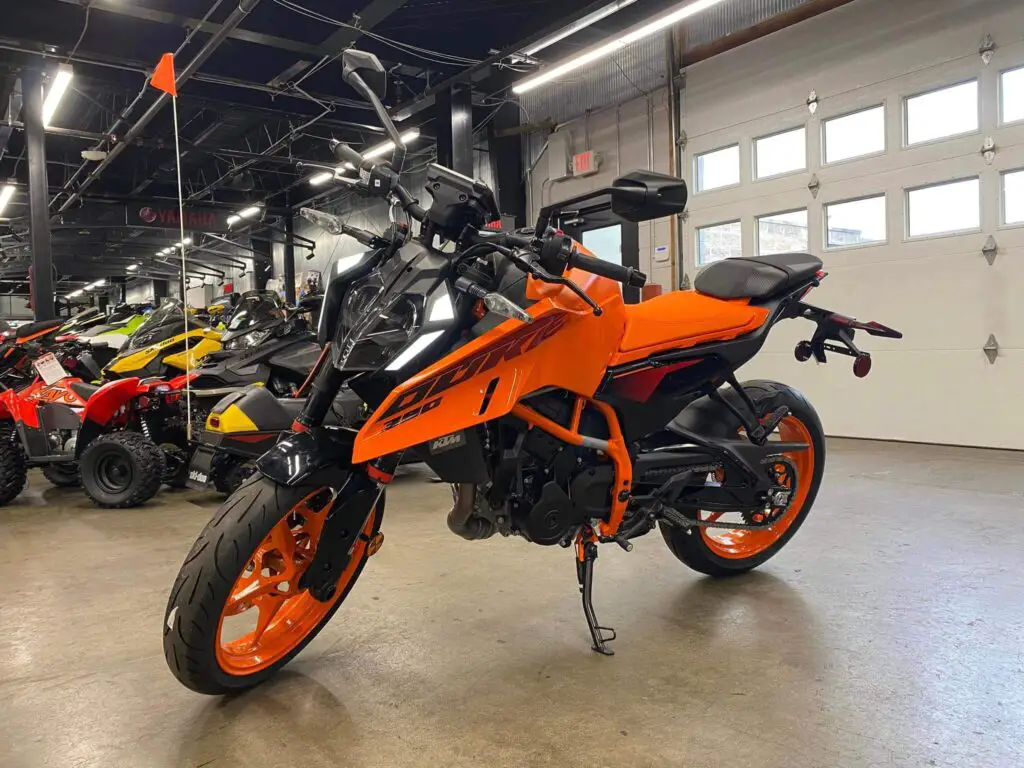
Speed requires stability and composure, especially for lightweight bikes susceptible to headshake. The Duke’s tubular steel trellis frame strikes a balance between stiffness for responsiveness and compliance for grip over bumps.
Fully-adjustable WP APEX suspension, tuned for aggressive street riding, helps keep the Duke planted during hard acceleration and high-speed runs. Firm, sportbike-like settings make this naked bike handle corners and sweepers more like a mini sportbike.
Answering The Braking Question
Hitting high speeds means little if you lack the brakes to rapidly shed that velocity before corners.
The KTM Duke 390 uses a single disc front and rear, sporting a large 320mm rotor up front. While entry-level bikes often lack top-end brake bite, Brembo’s high-spec Bybre monobloc caliper and radially-mounted piston aim to ensure power is not a bottleneck.
Completely overhauled ABS tuning for MY2020 further shortens braking distances in emergency scenarios – critical for real-world speed. Duke 390 riders praise the noticeable braking improvements, with minimal linked pulsing compared to earlier calibration.
So while on paper the specs seem underwhelming against supersport offerings, experienced reviewers report the binders are confidence-inspiring for aggressive riding.
“Braking power is pretty good for a single disc setup. The ByBre caliper provides enough bite and feel even when trying to bleed off triple-digit speeds.” – ZigWheels
Aerodynamics and Design
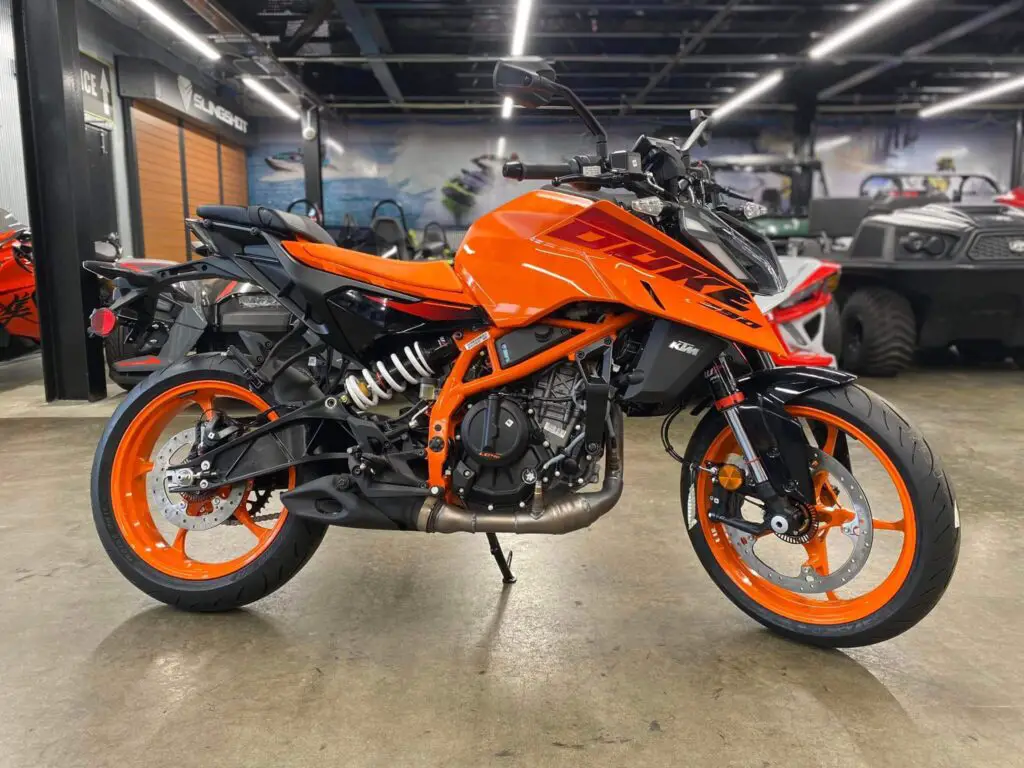
Bulky windscreens and fairings effectively cheat the wind – but add considerable weight. As a lightweight naked bike, the Duke relies on clever design elements to slide through the air efficiently.
Upright ergonomics present less frontal area compared to crouched supersport riding positions. Air flows smoothly over the narrow fuel tank to the tapered subframe. Small touches like the beak-style front fender and intake vents behind the radiator further reduce drag.
The 2023 model sheds weight by replacing the full LED headlight with a lighter projector unit. Reduced rotating mass also indirectly enables quicker acceleration and velocity. It’s no Koenigsegg, but efficient aerodynamic design allows the KTM Duke 390 to minimize drag and hold speed surprisingly well.
What Speed Is Realistically Achievable?
Straight-line speed is only one facet of bike performance, especially for public road riding. How does the KTM Duke 390 perform in more practical top speed testing?
Top Speed Tests
Multiple reviewers report hitting an indicated 106+ mph during velocity runs on closed courses and runways. Of course, indicated speedometers tend to over-read, so accounting for error these runs likely represent true top speeds of ~100 mph.
Impressively, some riders claim reaching the Duke’s limiter-imposed cut-off in 6th gear, suggesting there’s not much more to give. But there are always caveats…
Factors Affecting Top Speed
A bike’s absolute maximum speed requires an expert rider under ideal conditions. Small variables make a difference:
- Location (altitude impacts air density)
- Rider weight, size, skill
- Solo vs 2-up riding
- Break-in and engine Miles
- Tailwinds or drafting faster traffic
- Modifications (airbox, tune, exhaust, gearing etc.)
Considering these factors, average riders can expect ~106 mph top speed in the real world – but experts report speeds exceeding 110 mph.
Speed & Acceleration Impressions
“Get the throttle cracked open and the 390 will surge forward with a force belying its modest horsepower peak or cubbyhole dimensions. Acceleration is impressive for an entry-level motorcycle.” – Motorcycle.com
Owners praise the unexpected speed from such a small bike:
“This thing hauls! I stomp a 600 off the line almost every time. People don’t believe me until they see it.” – DukeRider29
But some note holding highway speeds requires working the gearbox:
“Fast for a 300 but you’ll be shifting a lot maintain 80+ mph unlike bigger bikes that can run those speeds effortlessly.” – ZillaChar
Comparison – Top Speed vs Rival Bikes
| Model | Engine Size | Wet Weight | Top Speed |
|---|---|---|---|
| KTM 390 Duke | 373cc | 362 lbs | 103-106 mph |
| Yamaha R3 | 321cc | 368 lbs | 112 mph |
| Kawasaki Ninja 400 | 399cc | 367 lbs | 116.7 mph |
| Suzuki SV650 | 645cc | 432 lbs | 130 mph |
| Honda CBR600RR | 599cc | 434 lbs | 160+ mph |
Despite a relatively small engine, the spunky Duke 390 surprisingly gives away little speed even compared to some larger models. Credit the light weight and short gearing for enabling highway-smashing velocities.
For context, common traffic travels 65-80 mph so anything above that threshold offers extra headroom to pass or escape trouble. The newest 390 Duke provides practical speed well above legal limits while remaining flickable around town.
Formula for Going Faster
More speed potential lies dormant in the KTM 390 Duke with Dukespeed-style modifications:
- Full exhaust (Akrapovic/Arrow/SC Project)
- Intake and airbox mods
- ECU tuning and engine work
- Gearing changes
- Sticky tires (Pirelli Supercorsa)
- Suspension upgrades and setup
- Rider weight reduction 😉
By extracting a few more horses and reducing parasitic losses, a built 390 Duke could plausibly touch 140+ mph given expert tuning and the right conditions.
But pursuing triple-digit velocities requires balancing performance with stability. Extended wheelies, sketchy headshake, and limited braking threaten the quest for speed and safety. We must recommend riding within your skill level.
Step-By-Step: Achieving Top Speed
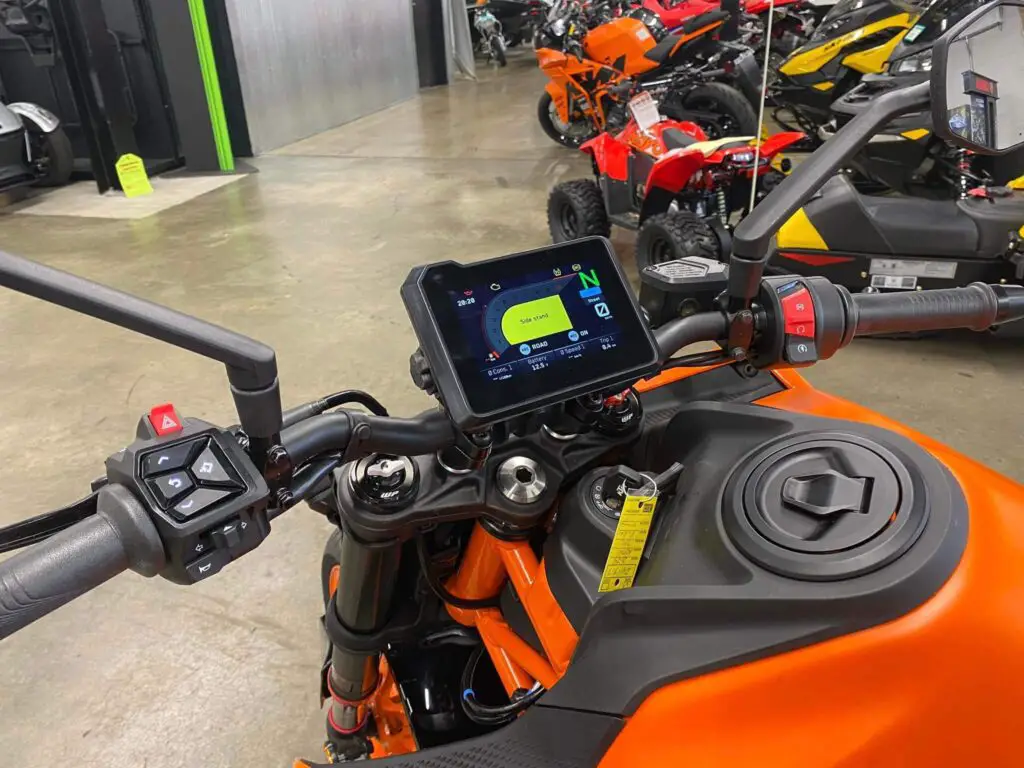
What does wide-open acceleration feel like aboard the orange speed machine? Let’s walk through the process of winding out the KTM 390 Duke from a dig to redline in each gear:
- Deactivate ABS (requires stop and 5 sec hold) for maximum braking performance
- Rev the responsive engine to ~6,500 rpm to spool the turbo-like single
- Dump the light clutch aggressively for a mini wheelstand
- Keep the throttle pinned as the front tire hammers down squirreling for traction
- Fastest 0-60 mph around 3.5 seconds with skilled clutch work
- Grab 2nd gear nearing the 10,500 rpm ceiling – Duke lunges forward
- Repeat full-throttle clutchless upshifts chasing the elusive velocity high
- Tuck to cheat wind blast approaching 110 mph in 4th gear
- 5th gear 180 km/h, 6th gear 210+ km/h 30% throttle modulation to prevent front lift
- Brake hard shedding 100 mph in just a few seconds!
The small 373cc thumper’s gobs of torque and short gearing make speed deceptively accessible. While top-end horsepower drops off early, the meaty mid-range muscle slingshots the KTM to 100+ mph.
Pros
From a speed perspective, strengths of the 390 Duke include:
- Lightweight single has torquey low-end then scream to redline
- Short gearing enables fast acceleration and 100+ mph top speed
- Nimble handling – quicker transition side to side than bigger bikes
- ByBre brakes provide sufficient bite for high speed bleed off
- Naked ergonomics reduce drag vs full-fairing bikes
Cons
- Peaky power delivery requires working the gearbox at highway speeds
- Exhaust pitch and vibey mirrors irritate some owners above 80 mph
- Limited range with small 3.5 gallon tank
- Wind blast above 100 mph challenges lightweight riders
- Only a 6-speed limits velocity vs. 8/9-speed sportbikes
Lightning Duke – Top KTM 390 Alternatives
Few bikes can run with the hottest Dukes, but worth cross-shopping are:
- Kawasaki Ninja 400 – Very close specs on paper with lower top speed.
- Yamaha MT-03 – Single-cylinder engine focused more on street fun than speed.
- Honda CB500F – Bigger 471cc twin but sporty ergonomics and power.
- Suzuki SV650 – Legendary V-twin flexibility with major tradeoffs.
Conclusion – Tiny Scalpel, Not Just Beginner Fodder
The 2023 KTM 390 Duke continues pushing the boundaries of what’s possible from a 373cc streetbike. While beginner-friendly, world-class componentry like WP suspension and ByBre brakes give it legitimate pace to run with middleweights.
Real-world top speed does not exceed an indicated 130 mph, but around 112 mph according to the YouTube expert. Brief straight line bursts see around 103-106 mph on flat ground with stock gearing, extending KTM’s claim of the “fastest way to work”.
Of course straight-line speed is just one aspect of bike performance. The Duke 390 remains flickable in corners with a balanced chassis. Still, KTM’s second-smallest Duke opens eyes by delivering acceleration and velocity belying its size. This entry-level orange bullet truly blurs the line between starter bike and pint-size sportbike.
What manufacturer will step up to make the next great small displacement speed demon? We’re excited to see how KTM answers with the next generation 390 Duke.
